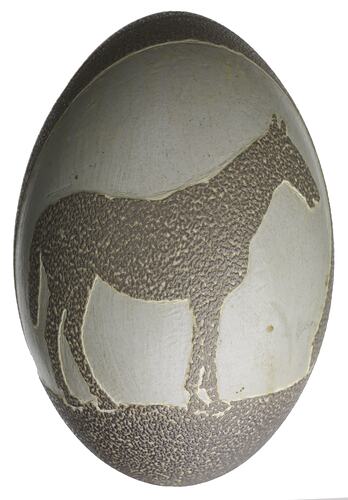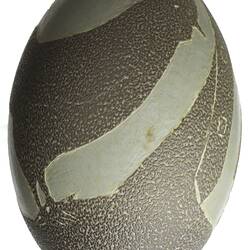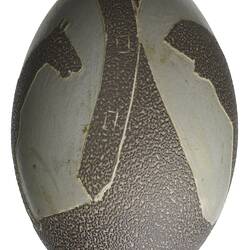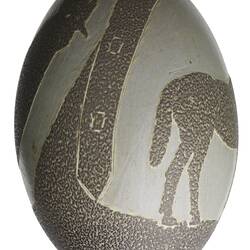Summary
The art of kalthi-parti carving, or emu-egg carving, became popular in the mid to late 19th century, and skilled First Peoples carvers of south-eastern Australia and the Carnarvon region of Western Australia continue the craft today. Some artists depict their animal totems, people, traditional designs and the landscape, displaying a rich visual history and reinforcing connections to country and culture. Others depict animals introduced by Europeans and that have become a part of the pastoral landscape. A kaangkaru (horse) standing under a horse shoe is carved on the front of this kalthi-parti (emu egg) and a tjuku-tjuku (chicken) has been carved on the back.
Many tools can be used for kalthi-parti carving, depending on the effect required. Tools used include stone, shell, shearing cutters, penknives, bone tools, metal files, steel wool and sandpaper.
Local Name
Kalti paarti
Physical Description
Emu egg. Incised design of horse and horse-shoe surrounding, hen and heart shape surrounding. One hole at either end for emptying contents. Yellow discolouration.
Significance
The Barkindji ('people of the river') are the largest of several groups which call the Darling River ('barka') home. Barkindji country extends from Wentworth in far south-west New South Wales, through Wilcannia and almost as far north as Bourke.
When Europeans came to the country of the Barkindji, the word 'kangaroo' entered the Barkindji language as 'kaangkaru', but meaning horse. To the Barkindji, this four-legged animal was as unusual as the word the Europeans used to describe the bounding creature they knew as kalatya (kangaroo).
Kalthi-parti carving is still practiced in many areas of Australia. Artists often tell cultural stories through their carvings which reflect past and present, depicting important traditions, people, animals and history.
Respected Barkindji cultural ambassador and artist Uncle William 'Badger' Bates continues the practice of kalthi-parti carving today and has been carving emu eggs since he was eight years old. Badger's grandmother, known as 'Grannie Moysey', brought Badger up, continuously travelling along the Darling River. Grannie Moysey taught Badger to carve from a young age and told him the creation stories which feature heavily in his art.
More Information
-
Object/Medium
Carving
-
Maker
-
Locality
-
Date Produced
-
Object Measurements
135 mm (Length), 75 mm (Width), 80 mm (Height)
-
Classification
-
Date Made
-
Maker
-
Clan/Language Group
-
Place Made
-
Indigenous Region
-
Keywords
-
Type of item
-
Discipline
-
Category
-
Collecting Areas




